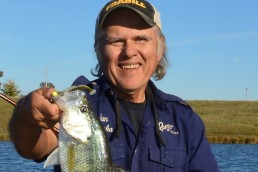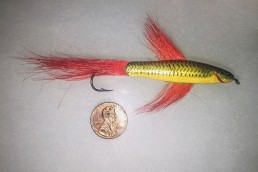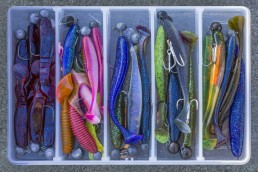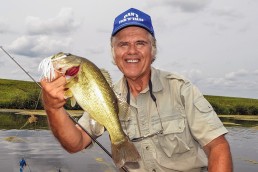‘Swimmingly’ Good
SHARE THIS POST
The past few years, the swimbait has surfaced to become as popular as the spinnerbait and crankbait. They have been around for a long time, but have improved dramatically through technology of modern-day designs and molds. I can remember in the ’60s when a French lure, “Vivif,” appeared via mail order. This rubber lure had a dramatic swimming action and a double hook on the bottom. The body tapered to a flat area that terminated with a flat-angled tail that was across its back, as is the case with modern-day lures. This bait had a fantastic tail-swimming action, but would sometimes snag in the bend of one of the hooks.
Today’s lures are made with softer plastics and have a number of different types of bodies and tails, all with the same purpose: to swim and catch fish.
So, how would one select the best one?
My way is to look at the tail to see the design. A solid paddle is best, with a thinner connection to the rest of the body. Also, the paddle tail shouldn’t have too much horizontal angle. I’ve discovered some that will defeat the swimming action by the paddle area not holding downward to catch water. Lures with a good paddle sometimes have this happen because the tail portion that connects to the body is just not strong enough to hold the paddle downward to catch the water.
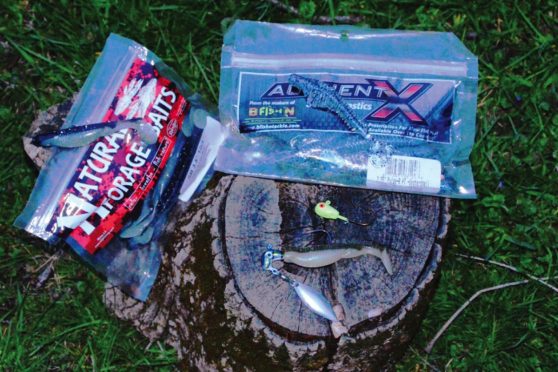
The next thing is the jig head, and there are a ton around. I like a design with a wire keeper instead of the lead collar like the B-Fish-N Precision H2O or Hutch’s. However, another favorite is Casey’s Road Runner Head, which has the lead color and keeper barb. I’ll use the Precision head on about any of the swimbaits as long as the hook size is not overpowered by too large of a body. With the Casey’s Runner, I want the lure not to have too deep of a body, which could interfere with the willow-leaf blade-action on the underside.
Sizes are another consideration, and there are several that run from 2 to 7 inches. I use the 2-, 3-, 4- and 5-inch sizes, with mainly 4 inches in a B-Fish-N Pulse-R and Natural Forage Baits Swim Bait. Both of these lures have a different design. The B-Fish-N Pusle-R has a ribbed body, which can create noise, air bubbles and holds scent. These ribs provide a little more flexibility in the tail area.
As for the Swim Bait, it has a solid body with slits in the lower side. I’m not quite sure why they do, but again, as with the Pulse-R, I think it creates noise, generates air bubbles and definitely is great for holding scent. In fact, Natural Forage Baits already has Kick’n Bass Attractants added in the body, creating an “odor zone” in the strike zone.
On the color, I like anything that looks similar to the baitfish that’s in the particular body of water being fished. Generally, the colors of smelt, shad, emerald shiner and green shad work well in most conditions.
Are you enjoying this post?
You can be among the first to get the latest info on where to go, what to use and how to use it!
Swimbaits can also be used as jig and spinnerbait trailers. I’ll use one with a Blitz Jig in White and swim it in areas where normally a spinnerbait would be used. It can bump the structure with less hang-ups and works when a spinner is a little too much for fish that are inactive.
Normal techniques for swimbaits are extremely easy, which makes it ideal lure for anglers of all experience levels. A simple steady retrieve will work as well as anything that’s fancy, but I’ve had some great results with a lift-and-fall and crank or rip-and-pause retrieve. The last two work well when fish are not as aggressive and are holding tighter to weeds and wood. When using the steady retrieve, vary the speed until the right one is found that produces the most strikes.
Swimbaits can be fished at any depth, but use the lightest jig head possible—just as you would with the lightest sinker possible on a plastic worm. This allows the lure to have more freedom and to have a slower, more natural fall.
Speaking of natural, be sure to hook the bait as straight as possible and not have it humped, crooked to the side or have its tail upward. Being straight on a hook with the hook coming out in the center will not only give the lure a natural look, but will also provide the optimum swimming action.
One of the nicest things about swimbaits is that they can catch any species. In fact, I’ve even caught carp and catfish on the smaller 2- and 3-inch sizes. While on the subject of the smaller 2-inch size, they can also be great for bluegills and crappies. With these, I’ll team them with the smaller Road Runner heads.
If you want to try an all-around “swimmingly good” bait, give the swimbaits a try.
MWO
SHARE THIS POST
Did you enjoy this post?
You can be among the first to get the latest info on where to go, what to use and how to use it!
Dan Galusha
Dan Galusha has fished all of his life, worked more than 45 years in the outdoor/media industry, and was inducted into the Fresh Water Fishing Hall of Fame as a Legendary Communicator. Direct questions through dansfishntales.com, facebook.com/dansfishntales and facebook.com/shootnplink.
